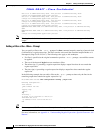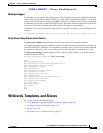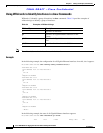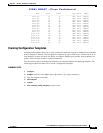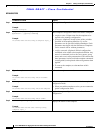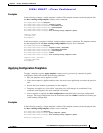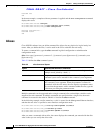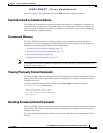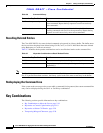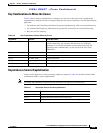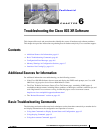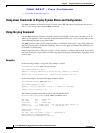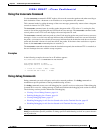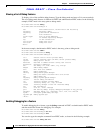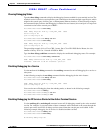
FINAL DRAFT —Cisco Confidential
5-18
Cisco ASR 9000 Series Aggregation Services Router Getting Started Guide
OL-17502-01
Chapter 5 CLI Tips, Techniques, and Shortcuts
Key Combinations
Recalling Deleted Entries
The Cisco IOS XR CLI also stores deleted commands or keywords in a history buffer. The buffer stores
the last ten items that have been deleted using Ctrl-K, Ctrl-U, or Ctrl-X. Individual characters deleted
using Backspace or Ctrl-D are not stored.
Table 5-7 identifies the keystroke combinations used to recall deleted entries to the command line.
Note The Esc, Y key sequence does not function unless the Ctrl-Y key combination is pressed first. If the
Esc, Y is pressed more than ten times, the history cycles back to the most recent entry in the buffer.
Redisplaying the Command Line
If the system sends a message to the screen while a command is being entered, the current command line
entry can be redisplayed using the Ctrl-L or Ctrl-R key combination.
Key Combinations
The following sections provide information on key combinations:
• Key Combinations to Move the Cursor, page 5-19
• Keystrokes to Control Capitalization, page 5-19
• Keystrokes to Delete CLI Entries, page 5-20
• Transposing Mistyped Characters, page 5-20
Ta ble 5-6 Command History
Command or Key Combination Purpose
Ctrl-P or the up arrow key Recalls commands in the history buffer, beginning with the most
recent command. Repeat the key sequence to recall successively
older commands.
Ctrl-N or the down arrow key Returns to more recent commands in the history buffer after
recalling commands with Ctrl-P or the up arrow key. Repeat the key
sequence to recall successively more recent commands.
Ta ble 5-7 Keystroke Combinations to Recall Deleted Entries
Command or Key Combination Recalls
Ctrl-Y The most recent entry in the buffer (press the keys simultaneously).
Esc, Y The previous entry in the history buffer (press the keys
sequentially).



